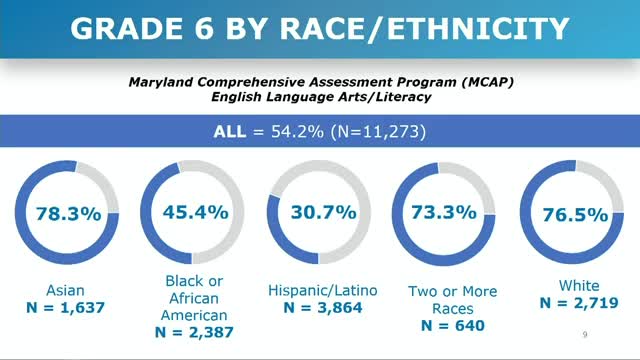Schools launch ambitious literacy initiative to boost student success
September 14, 2024 | Montgomery County Public Schools, School Boards, Maryland
This article was created by AI summarizing key points discussed. AI makes mistakes, so for full details and context, please refer to the video of the full meeting. Please report any errors so we can fix them. Report an error »

During a recent government meeting, education officials presented promising updates on literacy performance among high school students, revealing a notable increase in proficiency rates. According to the latest data, 61% of high school students who took the Grade 10 English Language Arts (ELA) literacy assessment scored proficient, marking a 5.9 percentage point increase from the previous year. This improvement is particularly significant as it represents the largest gain in literacy performance for this grade level from 2023 to 2024. Additionally, 15% of students scored just below the proficiency threshold, indicating that if these students were to improve, the overall proficiency rate could rise to 76.1%.
The meeting also highlighted the district's comprehensive literacy plan, which aims to address existing gaps in literacy performance through five key pillars. These pillars focus on foundational skills for early learners, access to high-quality and diverse curricula, literacy instruction across all content areas at the secondary level, and strategic data use for progress monitoring. For the current school year, the district has prioritized the successful implementation of a new English Language Arts curriculum, Amplified Core Knowledge Language Arts, at the elementary level, while emphasizing the elevation of literacy instruction across all subjects at the secondary level.
Officials discussed the importance of equipping teachers with the necessary resources and training to effectively implement these strategies. Professional development sessions have been conducted for over 4,200 elementary educators, with a focus on curriculum structure, planning, and differentiated instruction to meet the diverse needs of students. Feedback from these training sessions has been overwhelmingly positive, with 96% of participants feeling prepared to implement the new curriculum.
The meeting also featured testimonials from educators at New Hampshire Estates Elementary and Lakelands Park Middle School, who shared their experiences with the new curriculum and literacy strategies. Teachers reported increased student engagement and a positive shift in classroom dynamics as students began to connect with the material more effectively.
Overall, the discussions underscored a commitment to enhancing literacy education across the district, with a focus on continuous improvement and collaboration among educators to ensure that all students are equipped with the skills necessary for academic success.
The meeting also highlighted the district's comprehensive literacy plan, which aims to address existing gaps in literacy performance through five key pillars. These pillars focus on foundational skills for early learners, access to high-quality and diverse curricula, literacy instruction across all content areas at the secondary level, and strategic data use for progress monitoring. For the current school year, the district has prioritized the successful implementation of a new English Language Arts curriculum, Amplified Core Knowledge Language Arts, at the elementary level, while emphasizing the elevation of literacy instruction across all subjects at the secondary level.
Officials discussed the importance of equipping teachers with the necessary resources and training to effectively implement these strategies. Professional development sessions have been conducted for over 4,200 elementary educators, with a focus on curriculum structure, planning, and differentiated instruction to meet the diverse needs of students. Feedback from these training sessions has been overwhelmingly positive, with 96% of participants feeling prepared to implement the new curriculum.
The meeting also featured testimonials from educators at New Hampshire Estates Elementary and Lakelands Park Middle School, who shared their experiences with the new curriculum and literacy strategies. Teachers reported increased student engagement and a positive shift in classroom dynamics as students began to connect with the material more effectively.
Overall, the discussions underscored a commitment to enhancing literacy education across the district, with a focus on continuous improvement and collaboration among educators to ensure that all students are equipped with the skills necessary for academic success.
View full meeting
This article is based on a recent meeting—watch the full video and explore the complete transcript for deeper insights into the discussion.
View full meeting
